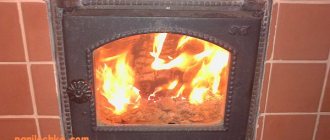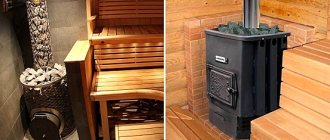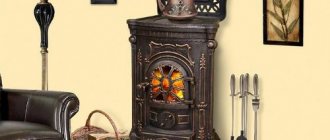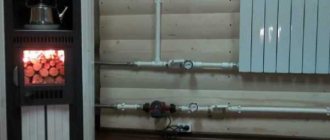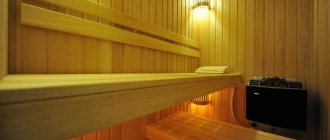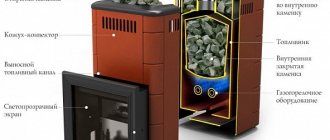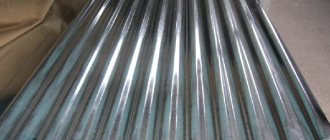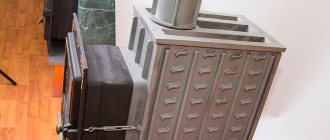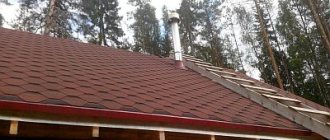Materials for building a fireplace stove
To build a stove with a brick fireplace you will need the following materials:
- durable red ceramic brick with smooth walls for external cladding and lining the internal surface of the chimney;
- refractory red brick for the combustion chamber of the stove and internal masonry, not necessarily with smooth walls;
- depending on the design - a ready-made metal built-in fireplace;
- cast iron products: furnace and blower doors, grates for the stove and hob, if provided for by the design;
- chimney valves;
- steel wire, corners, steel strips - for fastening doors and metal fittings in brickwork;
- stove mixture or good clay and sand for laying a stove;
- a water tank or coil for heating water, if provided for by the design;
- heat-resistant insulation to protect walls near the stove - asbestos, metal sheet, heat-resistant solid mineral wool;
- waterproofing for the foundation - roofing felt;
- cement or mortar, reinforcement, gravel, sand and boards for foundation formwork.
In building materials stores you can easily find everything for stoves and fireplaces.
The number of bricks of each type is calculated according to the order drawings. The remaining materials are selected and calculated locally and according to the needs in each specific case.
Question 5 - What material should I buy a stove from?
In stores there are stoves made of 3 materials: black steel, stainless steel, cast iron.
In accordance with calculations and experimental results obtained, 6mm black steel lasts as long as 2mm stainless steel. Most stores now have ovens with these thicknesses. Ordinary steel 3 is used as iron for furnaces. But chromium steel with 17% chromium is used as stainless steel. Chrome increases the service life of the stove by 3 times.
In black steel furnaces, it happens that manufacturers weld thicker sheets of iron up to 8 mm into the most thermally loaded areas. And in Feringer furnaces and in stainless steel furnaces, on the walls where the most loaded areas, in some models, additional screens are welded, increasing the service life of the furnaces. And what should you choose in the end – an iron stove for a bath or a stainless steel stove?
Our recommendation is that it doesn’t matter if the black steel is thick and you were actually sold a 2mm thick stainless steel stove, they will last the same amount of time, the only difference is that an iron stove is about 2 times heavier than a stainless steel one.
A cast iron sauna stove will definitely last longer than one made of black or stainless steel. But cast iron is afraid of sudden temperature changes - this is classic. Manufacturers add additives to cast iron during production, which reduces the occurrence of this moment to zero, but still there is a possibility that this will happen, at least psychologically. Our recommendation is to pour hot water on a cast iron stove, the temperature difference will be less, or don’t pour it at all, and the stove will serve you faithfully for a very long time.
Peculiarities
A stove for a summer cottage is a necessary attribute of a modern country holiday, used for heating rooms and cooking.
A brick stove with a fireplace has a number of important features that must be taken into account when planning the room in which it will be placed. First of all, you need to take care of a solid monolithic foundation for its installation. The stove has an impressive mass, so this rule should not be neglected and it is better to determine its location at the stage of designing the house.
An important feature of a stove with a fireplace is the presence of two fireboxes and chimneys that can be used independently of each other. An open fireplace insert quickly heats the room, and the stove retains the accumulated heat
The design provides long smoke channels, which reduces fuel consumption.
In a wooden house, special attention should be paid to the location of the stove and masonry materials to ensure the least possible fire hazard in a private house
How to distinguish a fake when purchasing?
Nowadays, a huge number of companies are trying to sell tempered glass for stoves, attributing to it heat-resistant properties, but in fact it does not have these properties and cannot be used in fireplaces and stoves, because it is produced using a different technology.
To avoid being scammed by such companies:
- When purchasing a product, it is important to always pay attention to the documentation of the product, and also purchase only from companies that have already taken a good place in the market for complete reliability.
- It is also recommended to study reviews on the Internet about the product you like and the company from which you want to order it, in order to be completely confident in your decision.
- And of course, first of all, pay attention to the presented characteristics of the product and make sure that they are suitable for you.
Choosing the size and shape of the fireplace
Any construction work begins with a project, and before you start building a fireplace, you need to decide on the size and shape of your fireplace, because not only its appearance, but also your safety depends on them.
What size fireplace is considered ideal? There is no definite answer to this question; you will have to focus on the size of the room, classic proportions and standard brick size.
- Determine the dimensions of the firebox. To do this, we measure the area of the room and divide it by 100. For example, for a living room with an area of 30 square meters, a combustion chamber area of 0.3 meters is sufficient.
- Finding the depth of the firebox. In relation to its width, the depth should be 1.5-2.5 times less. So, for a selected firebox area of 0.3 meters with a depth to width ratio of 1:2, the depth will be 37.5 cm - one and a half bricks, and the width 75 cm - three bricks.
- Find the height of the firebox. It should be 1.5 times greater than the width: for a firebox three bricks wide, we take a height of just over a meter, which corresponds to 14-15 rows of masonry.
- We determine another important parameter - the area of the smoke hole. It should have a ratio to the firebox area of 1:10 or 1:15. The chimney itself can be slightly wider, but the height of the straight section should not be less than 3 meters and more than 5 meters, otherwise it will be difficult to achieve stable draft.
The easiest way is to use ready-made drawings of brick fireplaces - in this case, you will not have to draw the layout yourself and will be able to avoid unpleasant surprises when lighting. From the proposed options, you will have to choose the fireplace that is most suitable in size and shape, after which you can purchase the material and get to work.
Question 4 – Type of door or whether we want to have a fireplace for the sauna.
What we are actually talking about: factories make two types of doors - with glass and without glass. As a rule, stoves are now purchased with a remote firebox so that they can be heated from an adjacent room, for example, from a dressing room.
If you buy a sauna stove with a large glass, you will be able to admire the fire in the firebox as if on a real fireplace. By and large, this is aesthetics, but a very pleasant one: you sit after the steam room, drink tea and look at the fire. But this modification increases the cost of the furnace by the price of glass. If the door is without glass, then you won’t be able to admire the fire.
Varieties
With a bed
The volumetric shape of such a stove is not suitable for all buildings. A miniature country house will be too small for a full-fledged heating system. But in a spacious room it will look harmonious. The stove and fireplace can be lit alternately - the combined option allows this. On the one hand, this is a cozy space with a crackling fireplace, and on the other, a full-fledged stove.
Most often, stoves with a stove bench are dacha installation options. In winter, massive stoves heat the house completely: the heat from the knee walls warms the whole night. Hence the understanding of why it is called a long-burning furnace. And if there is an option to install this design in your home, it’s worth taking advantage of.
Swedish oven
Another design of a combined stove is the Swedish one. It is distinguished by its compactness and the possibility of the same alternate use. If you touch the name, it immediately becomes clear that it comes from the country of origin - Sweden. The fireplace itself heats up quickly, since the mechanism with a heat exchanger has a hob. The Swedish oven is located between the walk-through room and the kitchen - this allows you to quickly heat a small space. The disadvantages include easy cooling, therefore, the inability to retain heat.
Wall furnace
A stove in which one side is in the wall is called a wall stove. This is a space saving option. It can be built in a small cottage to heat two rooms at once. Built-in structures allow it to be used in different ways - as a stove, and as a fireplace for aesthetic relaxation. It will heat the adjacent rooms behind the wall. The disadvantage of this mechanism is the lack of a cooking unit.
BBQ oven
Ordinary street barbecues are becoming a thing of the past. The stove can be used for barbecuing, and in this case it will be divided either into several separate planes and located directly on the street, or it will be built into the wall of the house, representing a single whole with the adjacent gazebo.
A barbecue stove refers to a mechanism that will be used alternately as a kitchen unit and as an outdoor fireplace. The structure is installed either on the outdoor gazebos of the dacha, or in the kitchen, which is made in high-tech style.
Mini ovens
Minimalism now is about earthiness and adherence to planes. A consistent minimalist style means the absence of protrusions.
Ready-made order schemes
- A corner brick fireplace is usually installed in a small living room or bedroom, because it saves space while heating it effectively. The layout of such a fireplace is shown in the figure. The dimensions of the fireplace are 1x1 meter. The outer walls are made of red ceramic bricks (2 hundred pieces), the firebox is made of refractory bricks (1 hundred pieces). In addition, you will need clay and sand, cement, and concrete for the foundation.
- The simplest brick fireplace design for beginner stove-makers is a real salvation, because to install this fireplace you will not need a lot of material, and it can heat a fairly large room - up to 35 square meters. The overall dimensions of such a fireplace are 65x115 cm, the number of ceramic bricks is about 250 pieces, fireclay bricks will need about 100 pieces. Also prepare two bags of oven clay, three or four bags of dry sand, and some cement. You will also need a pipe damper and a steel angle for the firebox arch. The arrangement of a brick fireplace “for beginners” is shown in the figure.
- A large living room in a classic style requires a solid English fireplace. To build such a hearth, you need experience working with brickwork and strict adherence to the diagram.
Necessary materials:
- red ceramic brick – 300 pieces;
- fireclay bricks – 130 pieces;
- oven clay or fire-resistant masonry mixture - a couple of bags;
- quarry sand – 4 bags;
- cement – 1 bag;
- metal corner and steel strip - 3 pieces of 1 meter each;
- stove door for cleaning the chimney;
- stove damper.
The diagram of a brick fireplace in the English style and its dimensions are shown in the figure.
Scheme of an English brick fireplace with a straight chimney - photo
The general techniques for laying fireplaces are very similar, so the article discusses the most complex option - an English brick fireplace with an oblique hood. You can learn how to build a corner fireplace made of bricks from the article about corner fireplaces, and laying a simple fireplace for beginners should not cause difficulties if you carefully study our recommendations.
Requirements for the fireplace foundation
The stability of the fireplace depends not only on the masonry, but also on the reliability of its base. The foundation for the fireplace must be poured separately from the foundation of the building, otherwise damage to the hearth and chimney may occur due to seasonal soil shifts. If the fireplace is installed against a load-bearing wall, a compensation cushion of sand is made between the strip foundation of the house and the base of the fireplace - it is poured between the foundations and spilled with water.
The height of the base under the fireplace should be such that the first row of masonry is at the level of the finished floor. The foundation pit can be shallow, but on heaving soils a sand and gravel cushion with a thickness of at least 0.5 meters must be made. A layer of sand and gravel compensates for soil shifts and prevents the capillary rise of water from it, which ensures waterproofing of the foundation itself and the walls of the fireplace.
The foundation is poured from M150-M300 concrete with mandatory reinforcement. The formwork is made from boards or plywood, fastening the panels with self-tapping screws. The size of the foundation to be poured must exceed the dimensions of the fireplace on each side by 10 cm. Drawings of brick fireplaces, as a rule, contain the required dimensions, and you can safely use them when pouring the foundation.
After pouring the foundation, the concrete should be kept until it reaches critical strength for about 5-7 days, after which you can begin marking and laying the fireplace, having previously laid a double layer of additional waterproofing - roofing felt.
Stove base and fireplace masonry
The necessary material that will be needed in order to build a fireplace is a ready-made mixture of stove mortar. If you prefer to make it yourself rather than buy it, then you will need:
- clay, as the main binding material when laying a fireplace;
- sand is a substance that is a filler; it should not contain foreign impurities;
- cement is added to the clay-sand mortar; it is especially necessary when working on an external chimney located above the roof. It is recommended to use high quality 400 grade cement;
- heat-resistant adhesive used when laying fireclay bricks.
Each folded row is carefully measured with a level. The firebox is made of refractory brick. The walls of the fireplace are not tied to the firebox, since fireclay and red bricks react differently to increased heat. They have different coefficients of expansion when exposed to high temperatures, so if you tie the firebox to the walls of the fireplace, the stove may simply fall apart. Therefore, there must be an air pocket between the outer walls of the fireplace and the firebox. A fireplace with a wood burning chamber in the form of / is the most efficient. Before making a fireplace from a stove, you need to select a sample portal and form the portal when laying the firebox.
Of course, the ideal, or rather, real fireplace is a stove with an open portal, however, some owners prefer to install a glass door on the fireplace, space for it is left on the second row, and joints in the masonry are made in the middle of the brick row, but in no case with edge.
Air pockets can be filled with broken bricks; they, like stones in a heater, will retain heat for a long time. A magnesium glass sheet is installed on top, which can withstand temperatures of thousands of degrees.
On the back of the firebox, on top of the glass-magnesium sheet, three bricks are laid in such a way that there is space on the front side for smoke removal. Immediately behind the front part, on the front side, a metal corner is laid along which the row is tied, into which the upper stove strips coming from the door are hidden.
The depth of the firebox is related to the height of the portal in a ratio of one to two or two to three. A shallower depth will cause smoke, a larger depth will reduce heat transfer. And the fireplace itself should not exceed 1/50 of the volume of the room.
Question 3 – Which stove should I buy?
Factories produce three modifications of furnaces: First
— sauna stoves with a closed heater, these are stoves for real gourmet baths; what distinguishes these stoves from others is that the stones in them are located in a closed heater. What this gives: the stones lie as if in an oven, they heat up evenly and when water is applied to them, they produce uniform, finely dispersed steam. The steam is scalding and soft. There are special devices in stock - evaporators, with the help of which water is supplied to the hottest stones located near the firebox, evaporating, it passes through all the stones, breaking into small dispersions and comes out as a dense, scalding cloud of steam.
Second
– sauna stoves with an open heater. The majority of stoves are offered with an open heater. With this option, the steam turns out just as hot and burns just as much. The most important thing is to choose the right stove for the volume of the steam room, why? If we take a stove with a large reserve of volume, we get the following: the air in the steam room will warm up faster than the stones can heat up, and then the stones will not have time to heat up normally and there will be little steam and it will be too wet. A stove properly selected for its volume will provide excellent steam and you can take a steam bath with great pleasure.
Third
— stoves with combined heaters. The design of these stoves has two heaters, closed and open. If in the first and second options the difference is obvious, in this case you will please both the company of amateurs and a professional in the bath business.
Features of operation
There are a number of conditions that are very important to observe when installing the stove. Neglecting these rules will make further operation of the fireplace stove difficult.
- The structure cannot be installed close to the wall. The required distance should be indicated in the instructions that come with the fireplace.
- There must be cladding on the surfaces of nearby walls. A ceramic stove is perfect for this.
- Do not install the structure on a bare floor. It is advisable to lay ceramic tiles or make a podium from bricks.
- The stoves weigh quite a lot, so additional racks should be installed to prevent the floor from sagging.
Conclusion
In conclusion, it is worth noting that no matter what efforts are spent on choosing, purchasing and installing a fireplace stove, they will more than pay off with positive emotions and a feeling of comfort that comes from a burning fire.
Works with glass
If you have already decided on the choice of glass suitable for your stove, for a longer service life, ensure it is properly cared for. Heat-resistant glass plays a protective role; the temperature inside the furnace reaches very high marks, so that soot residues may remain there. To clean them properly without damaging the glass, follow the tips below:
- To avoid damaging the glass polish with hard sand particles, do not use abrasive cleaners that contain them. Clean with special products to avoid consequences in the form of scratches;
- It is not recommended to clean when the glass has not yet cooled down after use. This can damage its protective layer.
Organization of cutting
If you choose to cut the glass to the desired size with your own hands, the ability to perform this action depends on its structure. If it is not hardened, it can be cut with a special glass cutter or a grinder and a segmented diamond blade. Let's consider an alternative cutting option using a grinder:
- Take a grinder and a segmented diamond disc for stone processing (it is better to use the one with the smallest diameter for ease of use), you will also need water or oil;
- Determine the exact dimensions of the intended glass, draw lines on it along which you will cut for convenience;
- Begin cutting carefully without performing strong pressing movements;
Glass cutting - Constantly wet the cut areas with water or oil to remove debris and keep the work area cool.
- Be prepared for the area to be messy when the job is completed.
Do-it-yourself oven installation
When installing yourself, you should follow all safety rules and take into account the following nuances:
- Do not exceed these expansion coefficients and use correctly selected frame material. To do this, you can lay a fire-resistant cord between the glass and the mounting base;
- The pressure of the installed parts on the glass surface must be the same at all fastening points;
- Attaching heat-resistant glass to the oven frame must be done very carefully; the use of heat-resistant sealant is prohibited;
- To eliminate the possibility of uneven overheating of the oven, the glass should not be allowed to be in direct contact with the oven frame and fastening elements.
Drawing a project for a corner fireplace
Before you start building a corner fireplace in your house, you need to draw up a detailed project and complete a drawing. The drawing must reflect all structural elements and indicate dimensions.
If you want to increase the size of the fireplace, immediately calculate how much additional material will be needed and how much power the fireplace will produce.
Below we present a masonry diagram, where the foundation of the combustion chamber will begin from the sixth row. You can slightly change this design, depending on the purpose of the fireplace and personal preferences.
If the main task of a corner fireplace is to heat the room, then the firebox must be kept low so that the floor is well heated, taking in cold air from below.
If the main purpose of the fireplace is a decorative function, then you can raise the firebox above the floor
Calculating the size of the combustion chamber
The dimensions of the fireplace will depend on the size of the room, so below we provide a table that will tell you how to correctly calculate the dimensions of the structure.
The area of the room must be divided by 50.
Correct proportions of the fireplace insert
This value will tell you what area the combustion chamber opening should be.
For example, for a medium-sized room (20-25 square meters), you need to make a fireplace with a firebox 0.5 m2 wide.
As for the overall dimensions of the structure, the ideal width-to-height ratio is 3:2.
As mentioned above, the depth of the firebox is of great importance. The efficiency of heating will directly depend on it. Adhere to approximately the following proportions: firebox depth = ½ or 2/3 of the firebox height.
The size of the fireplace must be maintained in a certain proportion
If you decide to increase the volume and depth of the combustion chamber for decorative purposes, keep in mind that this will significantly reduce the efficiency of heating the room.
Calculating the size of the chimney
It is equally important to correctly calculate the dimensions of the chimney, since the draft will directly depend on this. The optimal ratio is a pipe cross-section of 1/10 of the combustion chamber entrance area
The optimal ratio is a pipe cross-section of 1/10 of the combustion chamber entrance area.
If the chimney has a round cross-section (for example, if you use a sandwich pipe to build a chimney), then take a diameter of at least 150 mm.
The location of the chimney pipe on the roof relative to the ridge
With a smaller diameter, thrust will be significantly reduced.
The height of the chimney must be at least 5 meters. But if the house is 2-3 floors, then, of course, it will have to be raised. Here you will need to focus on the position of the roof ridge.
Below are certain patterns of chimney outlet, which are focused on the position of the roof ridge.
Important criteria for preparatory work
In order to complete all the preparatory work, avoiding the most common mistakes, which are very difficult to correct later, the following instructions will help you:
- Due to the large mass of brick kilns, there is a need to build a separate foundation. At the same time, it is not tied to the house, since subsequently it will undergo mandatory shrinkage, which should not appear on other elements of the building;
- The size of the foundation should be slightly larger than the fireplace itself on all sides (10-25 centimeters);
- To perform masonry work, you will need to buy both cheaper ceramic bricks, from which the main part of the structure will be made, and fire-resistant fireclay bricks. The second is needed to lay the elements of the firebox and chimney, which are subject to the most intense heat. It is worth noting that the price of fireclay bricks is quite high, and a lot of material will be needed;
- The seams between ceramic and fireclay bricks must be at least 5 millimeters, and the adhesive mortar itself is mixed based on clay and heat-resistant cement;
Stick to the same thickness of seams: optimally 5-7 millimeters
Stick to the same thickness of seams: optimally 5-7 millimeters
Corresponding recesses are left for each decorative element and fittings
Corresponding recesses are left for each decorative element and fittings
- Additional fittings and components (grate, ash pan, doors) are installed according to the diagram and are pre-purchased in a specialized store or made to order;
- For additional fixation of the doors, grate or ash pan, you will need to use annealed wire, which is installed between the bricks, after which it is filled with a solution for additional fixation and adhesion (preliminarily threaded into specially prepared holes and twisted with a bundle);
- In order to avoid too much variation in temperature conditions in the area of the combustion chamber, before installing it, be sure to extend a special asbestos cord between it and the bricks;
- In order to save effort and free time, the chimney can not be laid out with bricks, but give preference to a ceramic block variation (sold in a fully assembled state);
- If the brick does not have a very attractive appearance, you should take care of finishing such a surface. For these purposes, you can use any fireproof materials (tiles, ceramics, decorative plaster, heat-resistant paint, natural and artificial stone). Finishing a fireplace is not only a way to give the unit a unique style and individuality, it can also significantly increase the overall efficiency of the stove.
A brick fireplace stove for a summer cottage is an excellent opportunity to quickly and economically heat both a small and a two-story house with several rooms. In order to familiarize yourself with the variations of ready-made arrangements, we also recommend reading the article “Corner brick fireplace stove.”
What it is?
Heat-resistant furnace glass is an incredible advance in the development of glass production methods. Thanks to its composition and high-quality production method, it has:
- good sound insulation - muffles internal noise in the furnace;
- excellent strength - it is almost impossible to scratch or break it;
- high thermal stability - does not lose its resistance during sudden temperature changes;
- decent appearance - reliably watching the stove flame through it does not cause any discomfort;
- long period of use;
- guaranteed safety - sparks from the fire in the stove will not be able to penetrate into the room.
Other characteristics:
- It can be single-layer or multi-layer, which determines the number of degrees it can withstand: the greater the number of layers, the higher the possible temperature gap (up to 1000°C);
- Thickness is 4 or 5 mm, in some cases it can be thicker;
- For a longer period of use, you can use the maximum traction mode;
- It can have different external characteristics: transparent, colored, embossed, with a pattern.
Types of chimneys
The chimney acts as a channel system and is located inside the brickwork. The dimensions of the chimney directly depend on the dimensions of the fireplace stove. There are several types of chimneys:
- The simplest chimneys consist of certain sections that combine direct and return air flow. This design ends with a pipe. Return current areas are constructed from parallel channels. This is done in order to increase efficiency and improve air heating.
- Multi-turn chimneys. They differ from the previous ones only in the number of alternations of sections. The walls are heated more evenly because of this.
- Chimney without ducts. In such designs, everything is focused on the camera. Gases from the heil tend to the roof of the chamber, where they cool and descend back. The vapors give off their heat to the walls of the hood chamber. Exhaust gases exit into the pipe through openings at the bottom and side.
Any type can be used. It all depends on your needs.
Conclusion
All problems and possible dangers related to the open flame of a fireplace or stove can be solved by installing heat-resistant glass, which can withstand the effects of elevated temperatures for a long time. The amount of this time directly depends on the characteristics of the glass and the operating process. Laminated heat-resistant quartz glass is the most optimal, comfortable and effective among other options.
Advantages:
- Protecting the room from sparks from the stove, preventing contact with open flames, which is very important for families with children;
- Preserves aesthetic use - does not interfere with observing live fire;
- Plays a role in the image of the house, creates a pleasant impression of the good taste of the owner.
Beautiful examples
A dark antique-style fireplace stove will look amazing in rooms with walls decorated with decorative/natural brick, wood panels or stone. To make the interior harmonious, in such an environment you should place matte or varnished furniture made of natural wood with carved or curved details.
For a modern style, a round wall-hung stove is suitable. Ensembles in which a similar item is black, and the decoration and furniture are made in light colors, such as white, look especially organic.
Double-sided fireplace stoves look great in the middle of the room. With their help, you can create an original interior that creates a romantic atmosphere. The best options for creating such a cozy ensemble are those with brick or stone cladding.
For a review of the fireplace stove, see the following video.
Features of chimney installation
The inner surface of the chimney pipe is a straight channel, but its outer part has design features.
Design features keep you warm
At the intersection of the floor beam, the chimney has an expansion. This design element is important because it reduces the temperature of the outlet streams. As a result, there is no need to make additional thermal insulation in this place.
At the level of the intersection of the roof, the chimney has an extension. This feature protects the brickwork from the harmful effects of precipitation.
The smoke channel is also protected in the form of a metal cap. It is recommended to equip the chimney with a spark arrester.
What are modern sauna stoves like?
Experts divide all modern stoves into two categories based on the type of energy used: wood stoves and electric heaters. Each of them has certain advantages, which you should definitely know about in order to avoid mistakes when choosing the right model.
The design of a metal stove can be very different. Some of them are made using handicraft methods, from scrap materials and using gas welding. Others are created in factories and have a special design developed by professionals. But they all differ in how quickly the temperature rises. It is enough to lay dry, high-quality firewood and set it on fire, so that after 30-40 minutes the temperature in the bathhouse rises to a level suitable for washing.
The danger of carbon monoxide poisoning is completely eliminated. The stove is covered on all sides with metal, preventing smoke from entering the bathhouse. The stones from which the heater is made heat up as a result of the flame transferring heat to the iron, and the iron conducts them to the stones and gives off heat to them.
Alas, the classic metal sauna stove has a serious disadvantage. The heat capacity of such furnaces is not too high. They heat up quickly and, rapidly transferring heat to the room, quickly cool down. Because of this, conditions suitable for uniform heating of the body are not created. To correct this, experts recommend lining them with brick, leaving only a gap of a few centimeters for a layer of air. This not only allows you to retain heat for a long time (brick has a high heat capacity), but also reduces the risk of burns.
Some stoves even line the inside of the firebox with refractory bricks. This makes it possible to increase the heat capacity of the furnace and increase its service life.
In the manufacture of heater stoves, sheet iron with a thickness of about 5 millimeters is most often used. The water tank is located on either side - it depends on the installation location and the size of the bath.
Some models are made of stainless steel or regular zinc-plated steel. Their main advantage is their low weight and quick warm-up. Unfortunately, their durability is relatively short, and, even worse, they are not able to accumulate heat. It will be hot in the bathhouse as long as the fire is burning in the stove. But it is enough for the wood to burn out, and after just 10-20 minutes the temperature in the steam room will begin to rapidly decrease, which does not please users at all.
An alternative could be a cast iron stove. Yes, it weighs significantly more - sometimes up to 200 kilograms, which significantly complicates the installation process. But it is practically eternal. High temperature, high humidity - all this cannot cause the slightest harm to cast iron. Just look at the drawings of sauna stoves to be convinced that this is a truly monumental thing.
But such a furnace also takes much longer to heat up, that is, it has high thermal inertia.
Of course, another integral advantage of a classic stove-stove is the subtle smoke. Many people cannot imagine a real sauna without this smell.
Electric heaters are significantly different from conventional stoves. At the same time, they differ for the better. They are safe, convenient to use and very easy to operate. They have only one serious drawback - electricity tariffs are rapidly rising, and to maintain good heat in the steam room, an electric heater must work continuously.
The main design advantage of electric heaters is the multi-layer body made using sheet steel. It allows you to increase heat capacity and also reduce the risk of burns in case of accidental contact
When choosing an electric heater, be sure to consider the operating voltage of the specific model. It can be 220 or 380 volts. Models with power exceeding 7 kilowatts usually have a voltage of 380 volts. Don't forget that although stoves with a stainless steel body are more expensive than galvanized ones, they can last much longer.
More information about glass in a sauna stove-fireplace
All glasses are silicates in composition. However, the composition can vary , significantly affecting the mechanical properties of the glass. hardening , can affect strength and heat resistance .
Material and characteristics
Let's return to the two main categories of glass that are installed in fireplaces for baths.
Borosilicates
Silicon oxide is the main component of any glass . In addition to it, the composition usually includes soda and limestone . boron oxide is also added to them . Thanks to this additive, glass can withstand temperatures from -80 to 500 degrees.
On a note! Borosilicate begins to soften at 525 degrees.
In addition to temperature inertness, it also has chemical resistance. And yet you should not test it with hydrofluoric and phosphoric acids, as well as heated alkalis. Borosilicate is also resistant to sudden temperature changes.
By the way! Ordinary glass can burst under the influence of temperature, scattering into numerous fragments. Borosilicates do not break like that - they form large fragments without sharp edges.
Quartz glass
This variety can withstand even higher temperatures. It is made from pure quartz - in the form of sand, or the mineral rock crystal and vein quartz. Now the production of artificial silicon dioxide has also been established. The melting point of quartz is 1400 degrees .
Apart from silicon oxide, ordinary quartz glass contains no additives, which is the reason for its high heat resistance and chemical inertness. When the starting components are melted, either transparent glass or opaque glass . The only difference is the presence or absence of gas bubbles, from which the material becomes cloudy and becomes opaque. Of course, only clear glass is placed in a sauna stove with a fireplace.
Characteristics
When choosing glass for a fireplace stove in a bathhouse, the following matters:
- coefficient of thermal expansion . The lower it is, the better. It is especially low for pure quartz glass. Note that the next one depends on this parameter.
For your information! When heated, ordinary glass expands 30 times more than heat-resistant glass. This is a consequence of the presence of alkali metal oxides in it. Oxides of aluminum, boron and silicon, on the contrary, reduce expansion.
- heat resistance The limit to which the fireplace door can be heated without destroying it. A range of 500-550 degrees can be considered acceptable - the glass must withstand these temperatures for a long time . When you buy a stove or door, pay attention to the fact that with prolonged exposure to a higher temperature, the lifespan of the glass becomes significantly shorter. (The dates themselves are indicated in the passport). The manufacturer also indicates the maximum degrees for short-term exposure . Depending on the number of layers in the glass unit, this maximum can be 760 degrees or more than 1000 degrees .
IMPORTANT! In order not to expose the door to overheating, you must not overload the firebox with wood. Remember that a furnace operating at maximum risks not only glass, but also the metal of the body quickly turns into scale. You can also maintain the desired temperature using the draft - by increasing it, you reduce the heating of the door.
- glass thickness. This parameter is important from the point of view of greater or lesser fire hazard. Usually 4-5 mm is taken (this is quite enough), but it is possible to install thicker glass with an eye to greater resistance to flame.
Other characteristics are additional options. For example, glass color, lamination, relief, engraving.
Technologies and popular manufacturers
First, let's introduce an important distinction: tempered glass and heat-resistant glass are not the same thing. These are completely different technologies. In the first case, ordinary glass is taken and quickly heated by more than 600 degrees, after which it is just as quickly cooled by air on both sides.
This option is not suitable for a sauna stove-fireplace . Heat-resistant glass is glass with a certain composition, which was mentioned above. Moreover, the name “ glass ceramics ” is often applied to this variety.
The production of glass ceramics has its limitations. So you have to follow the rule about the impossibility of cutting, which is why the sheets are made in the size that will be used in the finished product.
Let's briefly go through the main technologies.
Lamination - the glass is covered with a protective layer, which, when the base is destroyed, does not allow the fragments to separate from the film.
Tinting is giving transparent glass certain shades. The meaning is mainly aesthetic, but they also say that tinting protects the eyes from excessive brightness.
Thermo-Rite
The most commonly used are warm shades - yellow, orange.
To combat soot that settles on the inner surface of the door, it was invented to apply a thin film of iron oxide, which leads to increased heating and automatic burning of soot.
Increasing strength is a task that has several solutions. There are technologies that use chemical reagents and surface polishing using open flame melting, which ideally smoothes out all possible flaws.
The products of certain manufacturers are most often found on our market:
- Schott Glas is the company that produces the Robax ;
- CrossFire Cerama is a borosilicate .
Installation and maintenance
- Since the door combines metal and glass, the coefficients of thermal expansion of both materials . a heat-resistant cord as a spacer between them .
Remedies for carbon deposits on stove glass
- It is also important to ensure that during installation the metal pressure on the glass is uniform over the entire joint area .
- Do not completely seal the seams , because this may cause the glass to crack.
- As for care, it should be recognized that even the most modern technologies do not eliminate soot on the surface. You'll have to fight on your own. On sale you will find special products to combat soot.
Danger! Do not use abrasives or aggressive cleaning agents under any circumstances . Abrasives leave scratches, and chemicals (for example, chlorine) are harmful not to the glass itself, but to the protective films on its surface.
Advice! If you don’t want to bother with cleaning a lot, choose drier firewood and non-coniferous wood .
Advantages of a fireplace for a wood-burning sauna
The use of wood-burning stoves in bathhouses became famous. This can be explained by many reasons.
A fireplace for a bath must be made in accordance with all fire safety regulations
For example:
- A sauna with a stone fireplace can be built anywhere; you can heat it at any time without worrying about wasting electricity. There is no need to worry about power outages. This applies to holiday villages and own houses, where firewood for such a stone stove-fireplace can be found in any forest belt.
- Combustible substances for a wood-burning fireplace are not in short supply, and they are also inexpensive. This also applies to firewood. They must be dried, only in this case you will get the desired effect of a healthy bath climate.
- You can heat a fireplace stove with wood much faster than waiting for an electric stove to heat the stones.
- Using firewood is an environmentally friendly and safe heating method.
- The ash remaining after the combustion of wood retains heat for a long period, which means heating the dressing room itself. A fireplace heated with wood can keep the heat from 12 to 14 hours, if the stove is made of brick, which accumulates heat and cools slowly.
Considering all the features of this design, you can safely install it. Well, if you want to do this yourself, then below you will find step-by-step instructions.
Fireplace in a bathhouse: what is it and why is it needed?
Well, it’s quite easy to imagine a bathhouse and a fireplace separately. Together, they mean that a stove designed to heat a steam room and create the conditions of your favorite type of bath can, among other things, also be a decoration. To do this, it is enough to abandon the solid metal door to the firebox and replace it with glass.
Video on topic
This is how it might look with a metal stove and a firebox with a fireplace door placed in the rest room, you get a fireplace in a bathhouse:
https://youtu.be/OfH_e4ER6VE
As for such a door, it is a metal frame into which a single or double glazing unit with special heat-resistant glass . The frame can be made of either steel or cast iron . If desired, you can supplement it with forged elements.
However, you should not consider a sauna fireplace stove solely as a decorative element. The practical use of a transparent door is the ability to visually monitor the combustion process.
In addition, the door limits convection from the side of the firebox, preventing heat from escaping with air currents. At the same time, it prevents sparks from entering the room, which increases fire safety . Along with sparks, smoke and soot cannot penetrate.
As an option, you can consider having two heaters in the bathhouse at the same time - a stove in the steam room and a separate fireplace in the relaxation room. This is cost-effective for large baths.
Safety rules for the construction of a bathhouse
It has already been written above how important it is when planning and constructing a bathhouse to strictly adhere to all standards and recommendations to ensure fire safety. Brick is the best material for fire protection, but despite this, it is necessary to maintain the minimum distance from the stove to the walls - no closer than 25 cm
A special base for the stove is laid on wooden floors to avoid fire. The ash compartment is located at a height of at least 14 cm from the floor
Brick is the best material for fire protection, but despite this, it is necessary to maintain a minimum distance from the stove to the walls - no closer than 25 cm. A special base for the stove is laid on wooden floors to avoid fire. The ash compartment is located at a height of at least 14 cm from the floor.
Following the simple rules described in the article will help you install the stove in the bathhouse correctly and protect yourself from unforeseen situations.
Fireproof, heat-resistant and heat-resistant - what's the difference?
When choosing glass for a fireplace or stove, special attention should be paid to its strength, because your safety primarily depends on this. It must be heat-resistant - resistant to sudden changes in temperature and capable of not deteriorating from sudden hot collisions.
An ordinary glass product, when in contact with a flame, heats up to 500°C in half an hour, while a heat-resistant glass product, when interacting with a fire, can heat up by about 70°C in the same time.
The essence of fire resistance of glass is safety first and foremost - it prevents sparks from entering the room from the furnace, and also prevents ash and soot from entering the room. Its heat resistance is approximately 700°C.
Heat-resistant glass is a unique type that includes both high heat resistance and high-quality fire resistance. Quartz glasses are the most heat-resistant, capable of withstanding oven temperatures of up to 1000°C.
Types of Kuznetsov furnaces
As mentioned above, the caps can be positioned in different ways, which is why there are a lot of options. The ability to install any heat exchange device in the second dome without damaging the combustion process also contributes to the presence of many different thermal units. At the same time, devices with any type of combustion can be designed according to this principle: upper, lower, pyrolysis, layer-by-layer, etc. They all have some specifics, but can be implemented. On Kuznetsov’s website, projects for various purposes are posted in order. They can be downloaded freely for personal use, but republication is not encouraged.
Fireplaces built on the principle of bell-type stoves
There are Kuznetsov stoves for two-story houses, and they heat both levels. Moreover, there are such units with beds. Heating can be of the convection type (only from the walls of the stove) or a water heat exchanger can be inserted inside. Then such a unit is called a boiler and is designated KIK. Four ready-made water-heating brick boilers with a capacity of 16 kW, 17 kW, 34 kW, 64 kW are publicly available on Kuznetsov’s official website. They can have a built-in tank for heating water for domestic needs. The boiler needs to be tied with metal corners, if necessary, it can be insulated, a reinforcing mesh should be laid on top and plastered.
Heating stove. Beautiful
There are many more options for convection ovens. In the section of heating and cooking furnaces without the use of fireclay bricks, OVIC, there are 25 different projects. There are three options for a heating and cooking stove with a fireplace. The fireplace can be located on the side (right or left). Such options are marked OVIK BK (side fireplace), there is an option with a stove bench and an OVIK BK 13l fireplace. For a fireplace located at the rear, the marking is OVIC ZK (rear fireplace).
Kuznetsov’s heating and cooking stove looks very decent
Purely heating thermal units are marked IOC. Orders that have a bed have the letters “lie” or “L” in their names; if there is an oven, the letter “D” is added. Heating stoves also have options with fireplaces. They are marked OIK K. There are calorific furnaces PKIK1X. A separate category includes ovens for greenhouses and bread ovens.
Heating stove Kuznetsov OIK. Impressive
Kuznetsov's Russian stoves are marked RTIC; a total of 10 models are laid out, two of which have stove benches. They have the usual configuration of a cooking chamber, the mouth of which must have a sealed valve. If the chamber is not sealed, the oven will not work normally.
Russian bell stove with stove bench
In the section of stoves for baths, Kuznetsov immediately offers an option for planning the premises, indicating the dimensions and showing how suitable models can be “fitted” there. After all, bathhouses are usually small, and while a metal stove can be placed in it easily, a large brick stove is already problematic. And you need to take into account many factors: where will the fire be fired from, where will the steam come out and the hottest part of the stove. And here are ready-made options. Very convenient and worth saying a big thank you to the author! The stoves themselves are placed in a separate category and are marked with BIC.
Kuznetsov's sauna stoves are marked with BIC. They look presentable and, according to reviews, have excellent characteristics
This video offers a design of a furnace designed according to the principle of constructing furnaces proposed by Kuznetsov. The first half talks about the movement of gases and how it works, about the principles of controlling the operation of a particular model. The second comments on the masonry process. Very useful and educational video.
DIY sauna stove with fireplace
An alternative to buying a stove from a large manufacturer or ordering from a master is still to make it yourself . In principle, why not if you have the relevant experience?
For our part, we recommend that you pay attention to the so-called “Kuznetsov stoves” - these are bell-type stoves developed by Igor Kuznetsov for heating a house or bathhouse. There are varieties with fireplaces . The author’s website contains order diagrams and other useful information on how to install a fireplace stove for a bathhouse with your own hands.
Below we invite you to watch a couple of videos. The first is a decent educational film on how to install a Kuznetsov stove, but it is not for a bathhouse, although the principle does not change.
The second video is about how to make a fireplace for a wood-burning sauna; there is useful information about the nuances of masonry and other secrets of the stove maker’s skill:
***
Well, we hope that soon a fireplace stove will appear in your bathhouse, which will not only warm the steam room, but will also gather guests and household members in the relaxation room near the live fire.
